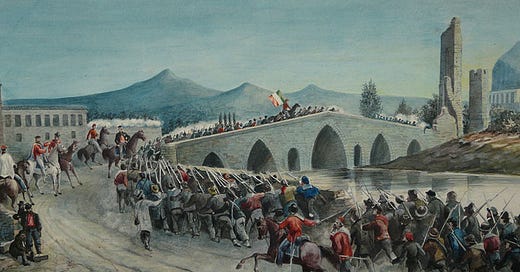The authorities in Palermo have closed the investigation into the Brancaccio gang who operated in Corso dei Mille, which is the long desolate road that leads east from the side of the station, and which I once walked down in order to visit the ponte dell’Ammiraglio, a medieval bridge now stranded in a park, thanks to the diversion of the nearby river. The Brancaccio gang are now out of business, or so we are assured, but what is interesting about this is what the coscha actually did, and how they came to be investigated in the first place.
One major activity was extortion, demanding protection money from tradesmen, what is called il pizzo. Three people are charged with paying the said pizzo, which they deny. One is a tobacconist, another operates a trattoria, and the third runs a bar. If you have been to Italy at all, you will instinctively recognise these sorts of places; they are small businesses, very small businesses. It is interesting to note that the Mafia operates at this level, street level, exacting a toll of maybe just a few euros a week from small traders. It all adds up, and no doubt people pay because it is not so very much, and they do not want trouble. But the pizzo represents more than money. It is tribute, it is an acknowledgement of feudal loyalty. Its exaction is a form of humiliation, and instils fear, or what the Mafiosi call ‘respect’. And the collection of the pizzo would presumably be a task for the entry-level gangsters, the teenage boys. Through the collection of the pizzo the boss gets to know, secondhand but reliably, what is happening in his territory, il mandamento.
As for the boys who collect the pizzo, they may not make much money, but they become known, they gain a reputation. Reputation is everything, and is based on the boy’s physical strength as well as his ingenuity when it comes to brutality. A strong fist is all very well, but what really counts is a devilish and innovative way of inflicting pain. This is essential training for the young Mafioso. In places like Corso dei Mille, the boss can have had little difficulty recruiting boys to collect il pizzo. High unemployment, lack of cash and lack of excitement make such ‘work’ very attractive.
But there is some pushback. The Giornale di Sicilia reports that some businesses are obsequious, but others defiant:
‘The investigation revealed that the owner of a car demolition company had apologized because he had not recognized the debt collectors and had not made himself available. And that, in Corso dei Mille, there was a pharmacy where it was better not to go because they were all "carabinieri" and "Addiopizzo", since they had installed some cameras to "trap" the extortionists.’
The pizzo is an essential part of any Mafia operation, but there are other things too that happened in Corso dei Mille. Because of the pizzo and its enforcers, the Mafia gains control of what Italians love to call la piazza, what we call ‘the public square’, that is, the public space in which drugs are sold, and of which they control the supply. So the extortion racket confers ownership of the streets which makes the drug dealing possible.
In addition, the Brancaccio gang made its cash through stealing cars and through illegal gambling. The car stealing used the ‘cavallo di ritorno’ (literally ‘post horse’ in the eighteenth century sense) method. One man steals your car; another man rings you up, saying you can pay to get it back; a third man goes to collect the money and tell you where to find the car. A very clever method, as it saves you having to sell the stolen cars.
However, business went wrong with the murder of Giancarlo Romano, a rising star in the coscha who had been under police surveillance for over two years, when he died in a shoot-out on 26th February this year., in via XXVII Maggio, just off the Corso del Mille. Romano was gunned down, but the man with him, Alessio Salvo Caruso survived; the latter had runup some debt with another pair of gangsters over gambling equipment.
The pair who carried out the half-successful murder were a father and son called Mira and were owed the paltry sum of 2,500 euros by Caruso, who refused to pay. This led to a quarrel, and a shoot out, with Romano being killed and Caruso badly wounded. Mira, father and son, were arrested the next day. After these arrests, someone must have spoken, and the entire coscha was put out of business.
So what went wrong, what can one learn from this? First if all, if you are to be a successful Mafioso, learn to control your temper, and above all, let the little things go, at least for a time. Don’t let everything be lost of a quarrel over 2,500 euro. Perhaps it was not just the money, but the wounded pride involved, or the desire to rub someone else’s nose in it. The lesson there is, of course, ‘to ‘keep your friends close, but your enemies closer.’ Don’t let your enemies suspect that they are your enemies, and then, whn they are off their guard, strike.





